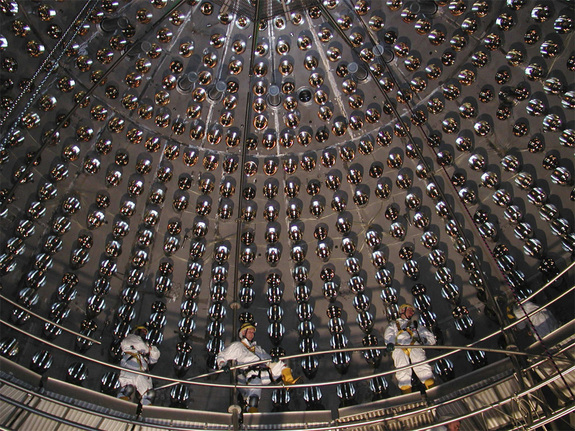Neutrinos Still Seem Faster than Light

The Italian physicists who announced two months ago that they had detected particles called neutrinos traveling faster than light now say they've done it again — and using an improved experimental setup. Many more tests will be needed, however, before the physics community accepts the revolutionary result as final.
"The experiment OPERA [Oscillation Project with Emulsion-tracking Apparatus], thanks to a specially adapted CERN beam, has made an important test of consistency of its result," said Fernando Ferroni, president of the Italian Institute for Nuclear Physics (INFN), which runs the lab where the experiment was conducted. "The positive outcome of the test makes us more confident in the result, although a final word can only be said by analogous measurements performed elsewhere in the world."
In both runs of the OPERA experiment, a beam of neutrinos — strange subatomic particles that don't interact with normal matter — was sent from the CERN Laboratory in Geneva, Switzerland, to the INFN Gran Sasso Laboratory near Rome, and arrived at their destination 60 nanoseconds faster than a beam of light would have done. That's shocking, because much of modern physics relies on Einstein's theory that the speed of light is the universe's speed limit. [10 Results of Faster-Than-Light Discovery]
However, since OPERA first publicized its results in September, physicists around the world have scrutinized nearly every aspect of the experimental setup, pointing out several potential flaws that, when corrected, might reveal that OPERA's neutrinos are traveling at less astonishing speeds.
The new test has addressed only one of those concerns.
Physicists had pointed out that the proton pulses that were used to generate the neutrinos that left CERN were of quite long durations, at 10.5 microseconds. Individual neutrinos received at Gran Sasso could have come from protons early or late in the proton pulse, creating uncertainty in their exact travel time, detractors said.
Thus, the OPERA team repeated their experiment using proton pulses that were 3,000 times briefer than last time, giving greater precision to the start time of neutrinos. With the beam tightened up, the neutrinos still arrived at Gran Sasso 60 nanoseconds faster than light would have. "This test confirms the accuracy of OPERA's timing measurement, ruling out one potential source of systematic error," the INFN statement said.
Sign up for the Live Science daily newsletter now
Get the world’s most fascinating discoveries delivered straight to your inbox.
However, many potential sources of error remain. For example, Ronald van Elburg of the University of Groningen in the Netherlands has argued that the Italian scientists failed to account for the fact that the GPS satellite they used as their timekeeping device is moving. If they had corrected for the motion of the satellite as Einstein's theory of special relativity requires, they would have measured the neutrinos arriving 64 nanoseconds later, van Elburg asserted. [Neutrinos? Not So Fast, Some Say]
The OPERA team responded that they had correctly used the GPS to synchronize their clocks at CERN and Gran Sasso. However, they now admit the possibility that there could be flaws in their timekeeping:
"One of the eventual systematic errors is now out of the way, but the search is not over. There are more checks of systematics currently under discussion, one of them could be a synchronization of the time reference at CERN and Gran Sasso independently from the GPS, using possibly a fiber," said Jacques Martino, director of the National Institute of Nuclear and Particle Physics of French CNRS.
Most physicists hope to see other groups, such as MINOS (Main Injector Neutrino Oscillation Search) at Fermilab in Batavia, Ill., conduct an independent test of neutrino speeds with similar experimental setups.
"OPERA is to be congratulated for doing some important and sensitive checks, but independent checks are the way to go," said Rob Plunkett, co-spokesman for MINOS, in a statement to the press. According to the journal Nature, MINOS could be ready to conduct such a test in early 2012.
This article was provided by Life's Little Mysteries, a sister site to Live Science. Follow us on Twitter @llmysteries, then join us on Facebook.Follow Natalie Wolchover on Twitter @nattyover.
Natalie Wolchover was a staff writer for Live Science from 2010 to 2012 and is currently a senior physics writer and editor for Quanta Magazine. She holds a bachelor's degree in physics from Tufts University and has studied physics at the University of California, Berkeley. Along with the staff of Quanta, Wolchover won the 2022 Pulitzer Prize for explanatory writing for her work on the building of the James Webb Space Telescope. Her work has also appeared in the The Best American Science and Nature Writing and The Best Writing on Mathematics, Nature, The New Yorker and Popular Science. She was the 2016 winner of the Evert Clark/Seth Payne Award, an annual prize for young science journalists, as well as the winner of the 2017 Science Communication Award for the American Institute of Physics.










